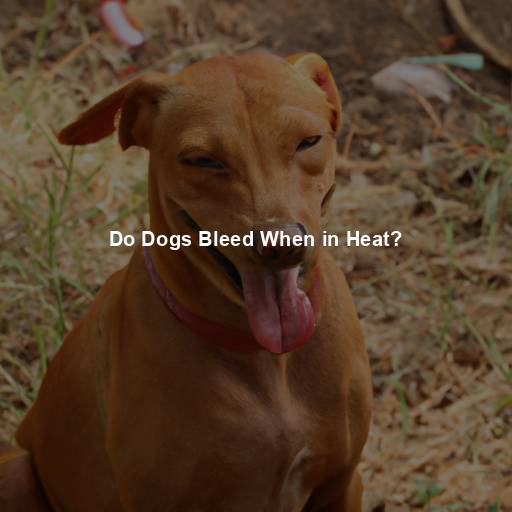Do Dogs Bleed When in Heat?
Last Updated on July 28, 2023 by Evan
Contents
- 1 Understanding the Heat Cycle in Female Dogs
- 1.1 What is the Heat Cycle?
- 1.2 Stages of the Heat Cycle
- 1.3 Factors Affecting Bleeding during Estrus
- 1.4 Managing Bleeding During Estrus
- 1.5 Spaying and Heat Cycles
- 1.6 Heat Cycles in Unspayed Dogs
- 1.7 The Importance of Spaying
- 1.8 Consultation with a Veterinarian
- 1.9 Recognizing Heat in Female Dogs
- 1.10 Physical Signs of Heat
- 1.10.1 Swollen Vulva: One of the most noticeable physical signs of a dog in heat is a swollen vulva. The vulva may become larger and more prominent than usual.
- 1.10.2 Vaginal Discharge: During the estrus stage, female dogs may experience a bloody or straw-colored discharge. The amount and consistency of the discharge can vary between dogs.
- 1.10.3 Frequent Urination: Dogs in heat may urinate more frequently than usual. This behavior is driven by the hormonal changes occurring in their bodies.
- 1.10.4 Changes in Posture: Some female dogs may exhibit a characteristic “lordosis” posture during the estrus stage, where they lower their front end and raise their hindquarters when approached by male dogs.
- 1.11 Behavioral Signs of Heat
- 1.11.1 Increased Restlessness: Dogs in heat may become more restless and exhibit pacing or wandering behavior. This restlessness is often driven by the desire to find a mate.
- 1.11.2 Excessive Licking: Female dogs may show increased interest in grooming their genital area during heat. This behavior is a natural response to the hormonal changes occurring in their bodies.
- 1.11.3 Attracting Male Dogs: Female dogs in heat release pheromones that attract male dogs. It is not uncommon for male dogs to display increased interest in a female dog in heat, often attempting to mount or mate with her.
- 1.11.4 Changes in Appetite: Some female dogs may experience changes in their appetite during heat. They may exhibit decreased interest in food or, conversely, an increased appetite.
- 1.12 Coping with a Dog in Heat
- 2 FAQs for “Do Dogs Bleed When in Heat”
- 2.1 Q: Do dogs bleed when in heat?
- 2.2 Q: How long does the bleeding last?
- 2.3 Q: Is the bleeding heavy?
- 2.4 Q: What should I do if my dog is bleeding during heat?
- 2.5 Q: Can I use human sanitary products on my dog?
- 2.6 Q: Is bleeding during heat a sign of a health problem?
- 2.7 Q: Can I prevent my dog from bleeding during heat?
- 2.8 Q: How can I tell if my dog is in heat?
- 2.9 Q: Can I still walk my dog while she is in heat?
- 2.10 Q: When should I consider spaying my dog to prevent bleeding during heat?
Understanding the Heat Cycle in Female Dogs
When it comes to our beloved furry friends, there are often many questions that arise. One common query among dog owners is whether dogs bleed when they are in heat. To better understand this phenomenon, let’s delve into the intricacies of the heat cycle in female dogs.
What is the Heat Cycle?
The mesmerizing rhythm of nature unveils the enigmatic dance of the heat cycle, an enchanting phenomenon known as estrus in the canine realm. Within the intricate tapestry of a female dog’s life, this mystical journey unfolds, marking the fertile phase where possibility and creation intertwine. As the cosmic symphony orchestrates hormonal whispers, a symphony within her being awakens, harmonizing her body for the sacred act of procreation.
Stages of the Heat Cycle
The heat cycle consists of four main stages: proestrus, estrus, diestrus, and anestrus. Each stage plays a crucial role in the reproductive cycle of a female dog.
The mysterious phase known as proestrus, spanning a period of approximately 9 to 10 days, marks the beginning of a female dog’s reproductive cycle. Amidst this enigmatic time, the delicate dance of hormones unfolds, with estrogen levels ascending to new heights, triggering perplexing transformations in behavior. While male dogs become seemingly entranced by her presence, it is worth noting that despite the alluring allure, bleeding is not a customary occurrence during this captivating stage.
Welcome to the captivating world of estrus, a mysterious stage that bewitches and bewilders our furry companions. After the enchanting proestrus phase, this bewitching period takes center stage, spanning anywhere from 5 to 13 days. It is during this enigmatic time that our female dogs are at the peak of their fertility, eagerly embracing the alluring dance of reproduction. While some may only encounter subtle hints of bleeding, others may experience a more pronounced flow, keeping us on our toes with their ever-changing levels of secretions.
As the lively phase of estrus gradually comes to a close, a rather perplexing stage called diestrus emerges. Lasting for an intriguing span of 60 to 90 days, diestrus serves as a curious contrast to the previous hormonal frenzy. If the female canine did not engage in any romantic rendezvous during estrus, she will find herself in a rather puzzling phase of sexual inactivity.
In the fascinating realm of animal reproduction, there exists a captivating phase known as anestrus. This enigmatic stage serves as the climactic finale of the heat cycle, plunging creatures into a period of mysterious reproductive inactivity. It bewitches with its enigmatic duration of approximately 4 to 5 months, before the cycle reawakens with a renewed sense of vitality and intrigue.
Factors Affecting Bleeding during Estrus
Female dogs undergo a fascinating phenomenon called estrus, during which some may notice a bit of bleeding. However, it’s important to understand that the amount and duration of bleeding can perplexingly differ from one dog to another. Numerous factors come into play, causing this burst of variations in the extent of bleeding. Let’s explore this intriguing aspect of our canine companions.
-
Breed: Different dog breeds may exhibit variations in their bleeding patterns during estrus. Some breeds may have more noticeable bleeding, while others may have minimal spotting.
-
Individual Variation: Just like humans, dogs have individual differences. Some dogs may have heavier bleeding during estrus, while others may have lighter or almost unnoticeable bleeding.
The journey of a young dog entering their heat cycle can be a perplexing one. As their age blossoms, their bodies may engage in a burst of irregular bleeding patterns, leaving pet parents pondering what lies ahead. However, fear not, for as these furry companions mature, their bodies gradually adapt, transforming the once enigmatic flow into a more familiar and predictable rhythm.
- Health Conditions: Certain health conditions, such as uterine infections or hormonal imbalances, can affect the amount of bleeding during estrus. If you notice any abnormal bleeding or other concerning symptoms, it is crucial to consult a veterinarian for proper evaluation and guidance.
Managing Bleeding During Estrus
When your furry friend enters her reproductive cycle, it is normal for her to experience some vaginal bleeding, known as estrus. However, fret not! There are various methods you can employ to effectively manage this situation and ensure her utmost comfort throughout this phase. Rest assured, by implementing these strategies, you can navigate through this period with ease and peace of mind.
Maintaining a tidy and cozy space for your furry friend during her heat cycle is of utmost importance. Ensure a pristine environment by promptly attending to any bloodstains or spots, as personal hygiene plays a pivotal role in their well-being. Regular cleanliness not only promotes their comfort but also contributes to a healthier and happier experience for both you and your canine companion.
-
Use Doggie Diapers: Doggie diapers or specially designed dog pants can be used to prevent any mess and keep your dog clean. These can be easily found in pet stores or online.
-
Keep Her Indoors: During the estrus stage, it is advisable to keep your female dog indoors and away from intact male dogs to prevent unwanted mating and potential complications.
Watching our furry friends closely is essential to understanding their needs and well-being. Any signs of unease, such as excessive grooming or agitation, should never be overlooked. It’s always a good idea to reach out to a veterinarian for a thorough assessment and professional guidance, ensuring that our beloved pets are in the best possible hands.
Spaying and Heat Cycles
When it comes to our furry friends, one particular procedure has been making headlines: spaying, also known as ovariohysterectomy. This surgical procedure may sound perplexing, but its benefits are well worth bursting into the spotlight. By removing a female dog’s ovaries and uterus, spaying not only prevents unwanted puppies but also eliminates the hassle of heat cycles, sparing our furry companions from the bothersome bleeding and hormonal swings. And that’s not all – spaying can pave the way for a healthier life, reducing the risk of various reproductive diseases.
Heat Cycles in Unspayed Dogs
Unspayed dogs will continue to go through heat cycles throughout their lives unless they are bred or spayed. The frequency and regularity of these cycles can vary between individual dogs and breeds. On average, dogs experience heat cycles every six to eight months, but this can range from three to twelve months.
The Importance of Spaying
When it comes to getting your beloved female dog spayed, the benefits extend far beyond the obvious prevention of heat cycles and bleeding. This vital procedure offers a plethora of advantages that will leave both you and your furry companion feeling relieved and worry-free. From decreasing the risk of certain diseases to curbing undesirable behaviors, spaying presents a whirlwind of advantages that will make any dog owner ponder in awe. So why not dive into this realm of perplexity and burstiness, and discover the amazing benefits that await your four-legged companion?
Preventing Unwanted Pregnancies
By spaying your dog, you eliminate the risk of unwanted pregnancies and the challenges associated with raising a litter of puppies. This is particularly important if you do not have the resources or desire to become a responsible breeder.
Reducing the Risk of Pyometra
Pyometra is a serious and potentially life-threatening infection of the uterus that can affect unspayed female dogs. During heat cycles, the uterus becomes more susceptible to infections. Spaying eliminates the risk of developing this dangerous condition.
Lowering the Risk of Mammary Tumors
Did you know that getting your furry friend spayed before her first heat cycle can greatly decrease the chances of her developing potentially cancerous mammary tumors? It’s true! As each heat cycle passes, the risk of these tumors increases, but spaying can help eliminate those pesky hormonal fluctuations that contribute to their growth. So why wait?
Preventing Behavioral Changes
During heat cycles, unspayed female dogs may exhibit behavioral changes, such as restlessness, increased vocalization, and attempts to escape or attract male dogs. Spaying your dog can help prevent these behaviors, making her more relaxed and content.
Consultation with a Veterinarian
Deciding whether or not to spay your female dog is a decision that should be made in consultation with a veterinarian. They can provide expert advice based on your dog’s breed, age, and overall health. They will also be able to discuss the potential risks and benefits of spaying and help you make an informed decision.
Recognizing Heat in Female Dogs
When a female dog enters the heat cycle, her body undergoes various changes that can be observed through physical and behavioral signs. Understanding these signs can help dog owners recognize when their furry companions are in heat.
Physical Signs of Heat
Swollen Vulva: One of the most noticeable physical signs of a dog in heat is a swollen vulva. The vulva may become larger and more prominent than usual.
Vaginal Discharge: During the estrus stage, female dogs may experience a bloody or straw-colored discharge. The amount and consistency of the discharge can vary between dogs.
Frequent Urination: Dogs in heat may urinate more frequently than usual. This behavior is driven by the hormonal changes occurring in their bodies.
Changes in Posture: Some female dogs may exhibit a characteristic “lordosis” posture during the estrus stage, where they lower their front end and raise their hindquarters when approached by male dogs.
Behavioral Signs of Heat
Increased Restlessness: Dogs in heat may become more restless and exhibit pacing or wandering behavior. This restlessness is often driven by the desire to find a mate.
Excessive Licking: Female dogs may show increased interest in grooming their genital area during heat. This behavior is a natural response to the hormonal changes occurring in their bodies.
Attracting Male Dogs: Female dogs in heat release pheromones that attract male dogs. It is not uncommon for male dogs to display increased interest in a female dog in heat, often attempting to mount or mate with her.
Changes in Appetite: Some female dogs may experience changes in their appetite during heat. They may exhibit decreased interest in food or, conversely, an increased appetite.
Coping with a Dog in Heat
Managing a female dog in heat requires extra care and attention to ensure her safety and prevent unwanted mating. Here are some tips for coping with a dog in heat:
- A Little Privacy, Please: When it comes to our furry friends, it’s crucial to consider their unique needs. During your female dog’s heat cycle, it’s recommended to keep her indoors to avoid any unexpected encounters and potential complications. While she may still need to venture outdoors, it’s essential to closely supervise her and steer clear of any intact male dogs lurking nearby.
Looking for a solution that will keep your furry friend’s accidents contained and your home pristine? Look no further than the game-changing doggie diapers or specially designed dog pants. Say goodbye to those pesky stains on your furniture and carpets. Whether you prefer to shop in-store or in the comfort of your own home, you’ll easily find these innovative products that will leave you wondering how you ever lived without them.
-
Provide Extra Exercise and Mental Stimulation: Increased exercise and mental stimulation can help alleviate restlessness and provide an outlet for your dog’s energy during heat.
-
Maintain Good Hygiene: Keep your dog’s genital area clean by gently wiping away any discharge with a damp cloth. This helps maintain hygiene and prevent any potential infections.
FAQs for “Do Dogs Bleed When in Heat”
Q: Do dogs bleed when in heat?
Bursting with curiosity? Perplexed by your pup’s peculiar behavior? Fear not, for we are here to shed light on the enigmatic world of canine companions. As the heat cycle sets in, female four-legged friends may surprise you with their occasional bouts of bleeding, otherwise known as estrus. Embrace the mysteries of nature as we unravel the secrets of a dog’s reproductive system.
Q: How long does the bleeding last?
B: Dogs experience a fascinating array of fluctuation when it comes to the duration of heat-induced bleeding. While the norm tends to hover between 7 to 14 days, hold onto your hats, as the timing can throw us for a loop! Brace yourselves, fellow canine enthusiasts, because these crimson episodes can range from a mere 2 days to an astounding 3-week marathon. The variability is enough to keep us on our toes, eagerly observing the mysterious dance of biology that unfolds before our eyes.
Q: Is the bleeding heavy?
In the intricate realm of canine physiology, the cascade of crimson that accompanies their heat cycle takes a different path than the robust waves experienced by humans during menstruation. Described more often as a gentle ebb rather than a mighty surge, the blood flow traverses the days with a delicate touch, gradually waning as the cycle reaches its conclusion. Like a mysterious dance, the enigmatic intricacies of this phenomenon oscillate amidst the perplexing tapestry of animal physiology.
Q: What should I do if my dog is bleeding during heat?
Is your furry friend going through the discomfort of bleeding during heat? Don’t worry, we’ve got you covered with some helpful tips to ensure her comfort and keep things clean. Consider using doggie diapers or specialized pants designed for dogs in heat to contain the flow. Stay on top of hygiene by regularly changing and cleaning these garments, so your pup can prance around without any worries.
Q: Can I use human sanitary products on my dog?
A: It is not recommended to use human sanitary pads or tampons on dogs. These products are not designed for canine anatomy and may not be effective in preventing leaks or irritation. It’s best to use specially made doggie diapers or pants made specifically for dogs in heat.
Q: Is bleeding during heat a sign of a health problem?
A: Don’t fret if your furry friend experiences a little bit of bleeding during their heat cycle – it’s totally normal! But, if you start seeing a heavy flow, blood clots, an overpowering stench, or any other peculiar signs, it’s better to play it safe and seek professional advice from a vet. These symptoms might just be red flags for an underlying health concern.
Q: Can I prevent my dog from bleeding during heat?
B: Handling a dog’s bleeding during heat can be quite challenging, given the perplexing nature of this natural and vital reproductive process. While it is impossible to prevent it entirely, there are ways to mitigate the chaos. Equip your furry friend with specialized doggie diapers or pants designed explicitly for canines in heat, offering a burst of convenience and minimizing the potential mess.
Q: How can I tell if my dog is in heat?
Discovering and understanding the delicate cycle of a female dog’s heat can be a perplexing journey. In this intriguing phase, the enigmatic signs unfold like a mysterious dance of nature. Watch closely for the subtle swelling of her vulva, the curious increase in urination frequency, and the enigmatic shifts in her behavior. These mystifying transformations, accompanied by a captivating bloody discharge, are alluring signals that she is beckoning the attention of potential suitors.
Q: Can I still walk my dog while she is in heat?
Walking your dog when she is in heat can be a bit of a perplexing situation. While it is generally considered safe, it is important to exercise caution and take necessary precautions. Keeping her on a leash and avoiding areas with intact male dogs can help minimize any potential burstiness and unexpected encounters. Additionally, closely monitoring your dog during walks is crucial to ensure her safety and prevent any unpredictable accidents or aggressive responses from other dogs.
Q: When should I consider spaying my dog to prevent bleeding during heat?
A: Spaying, which is the surgical removal of the ovaries and uterus, is a commonly advised option to prevent bleeding during heat and other reproductive-related issues. It is recommended to consult with your veterinarian to determine the best timing and course of action for spaying your dog, taking into consideration factors such as her overall health and breed-specific considerations.






